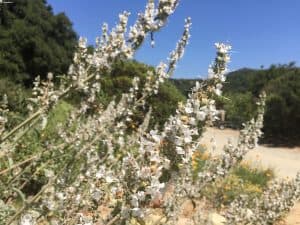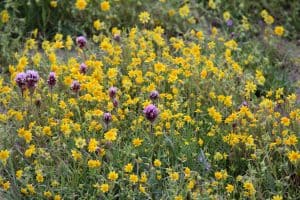Do you find yourself asking what should I be doing in my garden now? If so, read on to learn what you can be doing this month to prepare your garden for the hot summer months.
Spring Bloom Finishing

We have had a fantastic rain year with ample moisture producing one of the best flower seasons ever. I hope everyone got out and got a lot of photos. Whether in our beautiful wild places or in your garden, this has been a great year for spring bloom. Many native species stay in flower a long time, especially near the coast and at higher elevations. In some areas, spring blooms will continue through May or June, depending on the weather.
Summer Bloom Pretty Soon
We will have lots of flowers this summer too. Shade plants, desert plants and heat loving plants such as canyon sunflower, fairy duster and California fuchsia will bear bright colors through August. With the soaking rains from last season, our goal as gardeners will be to lock in the precious deep moisture by occasional deep waterings, starting in mid-May.
Getting Ready for Summer
Watering
Let’s assume that in your established native plant garden, you have not watered since about last October. At Tree of Life, we recorded around 20 inches of precipitation, with storms and rainfall nicely spaced perfectly throughout the season. We have not watered our grounds at all since before the rains. This has always been the ideal with natural gardens and rain-year 2016/17 has made it an attainable goal.

Now we need to look at root depth. Plants with shallow roots, annuals and soft branched perennials will need water to extend their growing time. However, the days are getting longer and pretty soon hotter, so trimming will be in order as well. See pruning tips below. Plants with deep roots probably have moisture from the rains still available, but we need to water for the upcoming dry season. Our gardens will soon be ready for their first good deep soak of the season.
Choose a period when it is not dry and hot. Apply 1-1.5” of precipitation. On average, this would mean watering with sprinklers for 2-3 hours… not practical, nor very effective, too much runoff, and sloppy puddling. Here’s how to do it: Water three days in a row, 20-30 minutes per day, with early morning start times. Yes, three consecutive days. This is your irrigation “event,” and you will be thoroughly soaking the ground the way rain showers do. This is called “pulse irrigation.” If you do this in mid May, you will probably not need to do it again until mid to late June. Water on intervals 3-5 weeks between irrigation events.
Pruning
Lush spring growth on native plants makes excellent browse for deer. Lacking deer in your garden, you should prune as if a deer were feeding… ceanothus, coffeeberry, chamise, coyote brush, desert lavender, coastal sunflower, lemonade berry, and others can be headed back by pruning off most of the new growth. Sages and buckwheats that are not blooming can be cleaned up in like manner. You can remove dead flower stalks from penstemon (unless you want seed), and shape any plant that has grown out of proportion during the wet season. As a precaution against spreading disease, occasionally dip your shears in 10% bleach solution or sanitize them with rubbing alcohol. Rinse and dry thoroughly before putting them away.
Feeding
Native plants tend to slow their growth in summer, and you do not want to artificially encourage new growth at this time. Most feeding can wait until early fall. If you have a plant that for some unique reason is lacking nutrients, you can apply fertilizer to that plant; a light dose of all purpose organic plant food is fine.
Weeding
Winter rains may have brought a lot of weed growth to the garden. Pull them or cut them with a hoe. For tenacious warm-season perennials like nutsedge and bermudagrass, you will need to use a contact systemic herbicide. Be very careful about overspray and wind drift or you will kill your garden plants.
Annual Wildflowers

If you planted wildflower seed last fall, you have had a wonderful show of annuals this spring. As the seeds fall, you can mangle up the dried plants and leave the stems and leaves in place as mulch or mangle up the plants so the seed will stay in your garden and you remove the dried plants. It all depends on the “look” you want. Remember, birds and other critters need nesting material, so any natural stuff you leave lying around is helpful to them. They like variety.
Mulching
If your organic mulch is getting tired or seems a bit too thin, it’s time to add new mulch. Very important: Do not pile mulch around the main stem or low branches of your plants. Do not use a compost or mulch that smells bad… it is still breaking down and the heat and off-gassing can be terrible. Do not apply too thick (in most cases 2 – 3” is plenty). You should find a clean wood-based, gritty chipped product. Do not use dusty or stringy mulch as a topdress around plants. You want water to run through it. You do not want it to form a dry impenetrable mat. Wood chips about 1/2” – 3/4” size are good. Avoid products that have been painted or dyed.
If you are gardening without mulch (natural topsoil and accumulated fallen leaves, native organic matter), or you have inorganic mulch, (rock, pebbles, DG or sand), you can just tidy up around the plants and add high quality mulch to certain areas to keep bare soil from baking.
Adding New Plants
With a few weeks of not-too-hot weather ahead, you can always plant a few new plants in open spaces or new areas of the garden. Come on over and we’ll help you find just the right plant.
Engage
These garden tasks should not be confused with “work.” These are not hard chores or garden busy work. You are not mowing, edging, hacking, and blowing leaves and dust everywhere. You are carefully tending a natural garden to get it ready for summer. Enjoy your time out there with your plants and with all the ”fellow mortals” (John Muir’s term) who also rely on your place for their wellbeing. Take in the sights, sounds, smells and beauty of your garden during a season of transition.
From the Garden,
Mike Evans
Call Us
Questions? Help is just one call or one email away. Call (949) 728-0685 or email (with pictures if you like) inquiries@californianativeplants.com
Featured Photo Credit: Alisa Flint, Tree of Life Nursery © 2016